
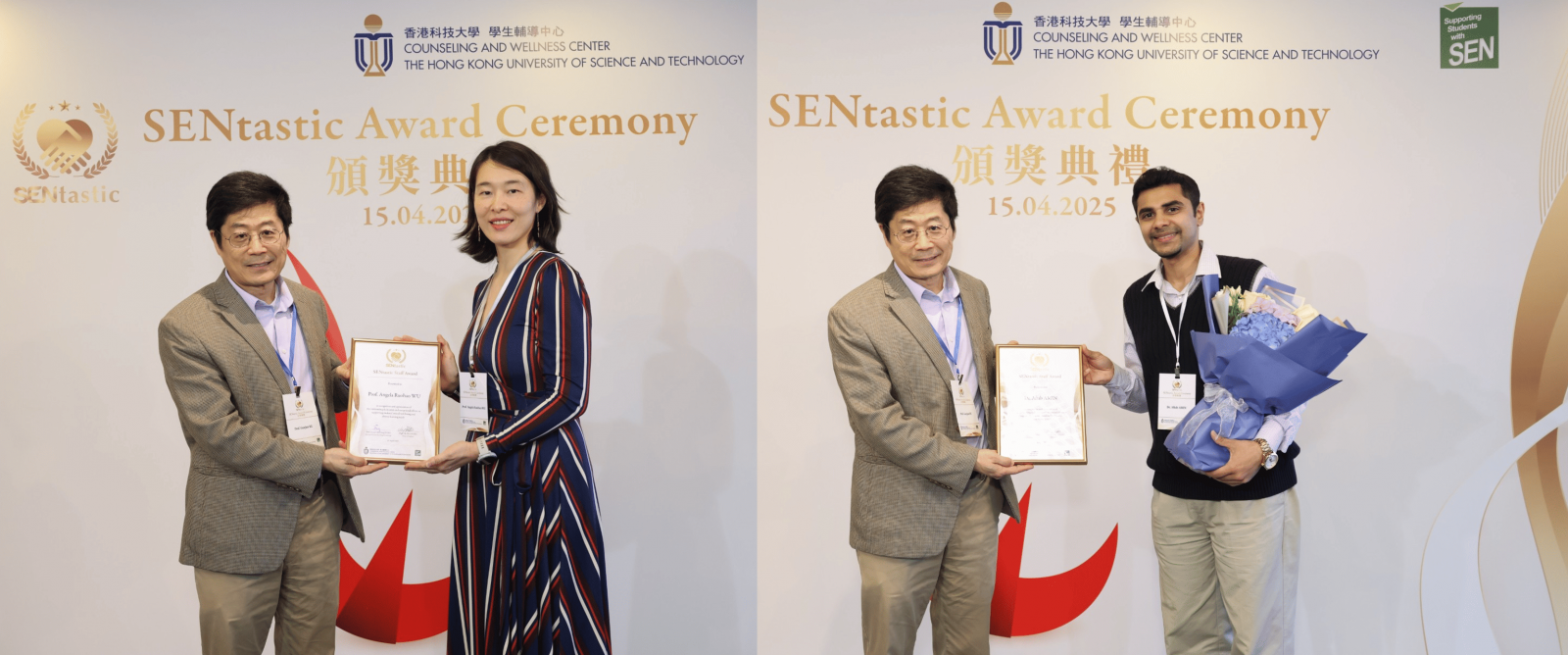
Prof. Angela WU, Associate Professor of Division of Life Science and of the Department of Chemical & Biological Engineering (left picture) and Dr. Aftab AMIN, lecturer of Division of Life Science (right picture) are recipients of the SENtastic Staff Award 2025.
This award honors the dedication of our faculty and staff for their exceptional efforts to enhance the well-being of our students, address diverse learning needs, and support special educational needs. It also serves as a platform for sharing best practices among educators and support staff, inspiring them to maintain their commitment to student care.
Congratulations to Prof. WU and Dr. AMIN and thank you for their contributions to create a more inclusive and supportive learning environment for all students!
For more information, please visit the following link:
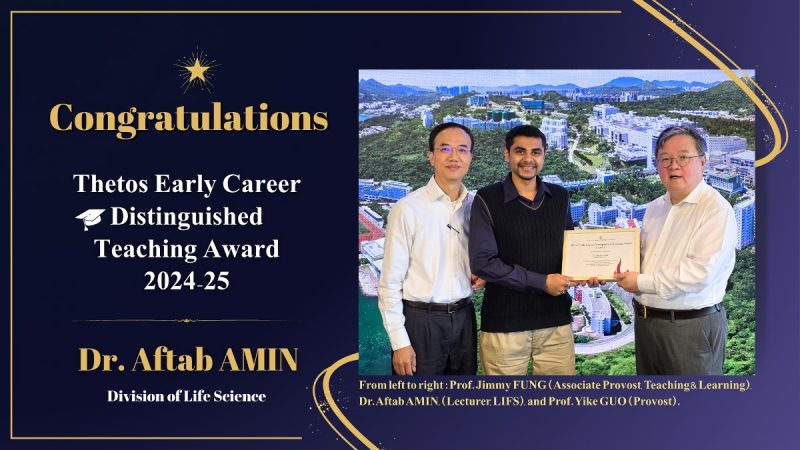
Dr. Aftab AMIN, a lecturer in the Division of Life Science (LIFS), who obtained his PhD in Life Science at HKUST, has been awarded the prestigious Thetos Early Career Distinguished Teaching Award, 2024-25.
The Thetos Distinguished Teaching Award, established by the Thetos Foundation, is the first award at the University dedicated exclusively to recognizing the contributions of teaching-track faculty. It honors their excellence in teaching and supports their initiatives for teaching advancement and personal development.
The Selection Committee, convened by Prof. Jimmy FUNG, the Associate Provost for Teaching & Learning, undertook the challenging task of reviewing the portfolios of a distinguished group of candidates before making final recommendations to Prof. Yike GUO, the Provost.
These awards acknowledge the exceptional dedication, innovative teaching methods, and significant contributions of faculty members to the educational mission of the University.
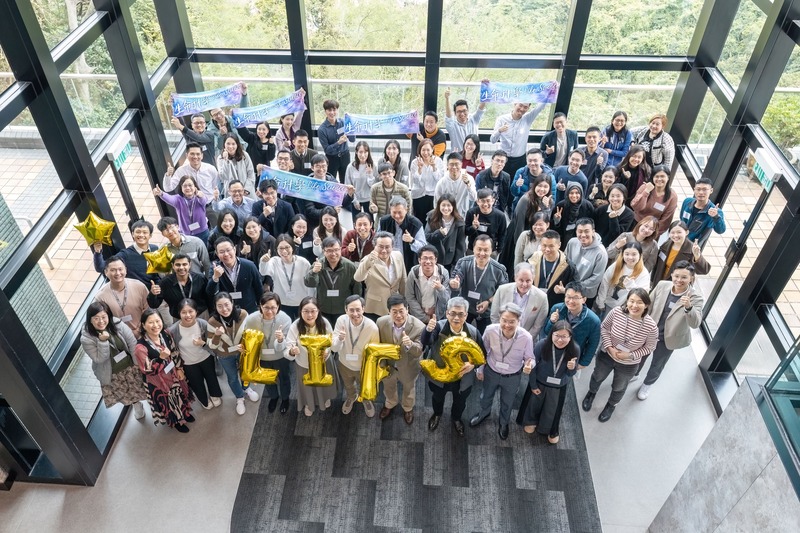
More than 50 alumni from the Division of Life Science (LIFS) returned to campus on 8 March 2025, to reconnect with fellow alumni and professors at the LIFS Alumni Homecoming 2025.
The event was inaugurated by Prof. Guojun BU, Head of Division, to kick off the lunch reception with a warm welcome and insightful updates on the latest developments within the Division. Representatives from the Life Science Alumni Association (LSAA) seized the opportunity to introduce the LSAA and shared their exciting upcoming agenda, followed by a heartfelt toast from the LIFS faculty members.
The homecoming lunch provided a wonderful opportunity for alumni and faculty to rekindle old friendships and foster new connections. By hosting regular meetups, the Division aims to strengthen the alumni community and cultivate a lasting sense of belonging.
Look forward to more LIFS get-togethers in the future! Stay informed about the Division of Life Science: https://life-sci.hkust.edu.hk/
See more photos of the event here.
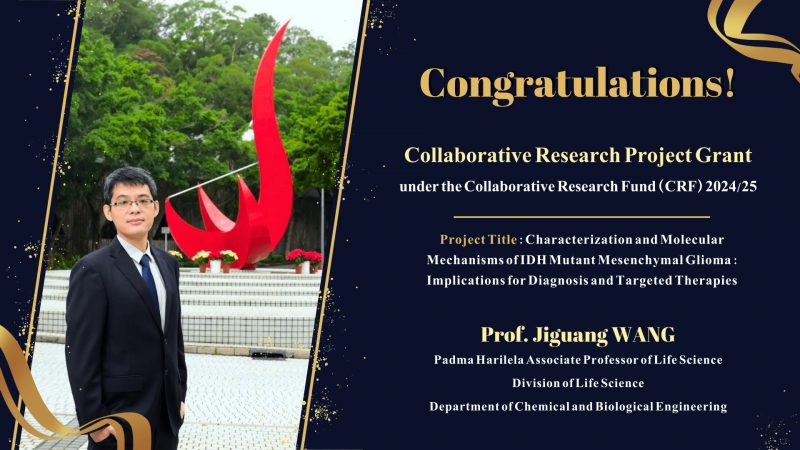
The Research Grants Council (RGC) has announced the results of the Collaborative Research Fund (CRF) 2024/25.
Congratulations to Prof. Jiguang WANG, Padma Harilela Associate Professor of Life Science (Division of Life Science (LIFS) and Department of Chemical and Biomedical Engineering (CBE)) for being a recipient of the Collaborative Research Project Grant (CRPG) under the Collaborative Research Fund (CRF) 2024/25.
Led by Prof. WANG, with HKUST co-investigators Prof. Shuhuai YAO (Mechanical and Aerospace Engineering (MAE) and CBE), Prof. Kai LIU (LIFS and CBE), and Prof. Can YANG (Department of Mathematics (MATH)), their project titled ” Characterization and Molecular Mechanisms of IDH Mutant Mesenchymal Glioma: Implications for Diagnosis and Targeted Therapies”, has received HKD 6 million from RGC. The project will run from 30 June 2025 to 29 June 2028, marking a significant step forward in glioma research.
The CRF supports multi-investigator, multi-disciplinary projects in order to encourage more research groups to engage in innovative and high-quality cross-disciplinary / cross-institutional collaborations.
Read More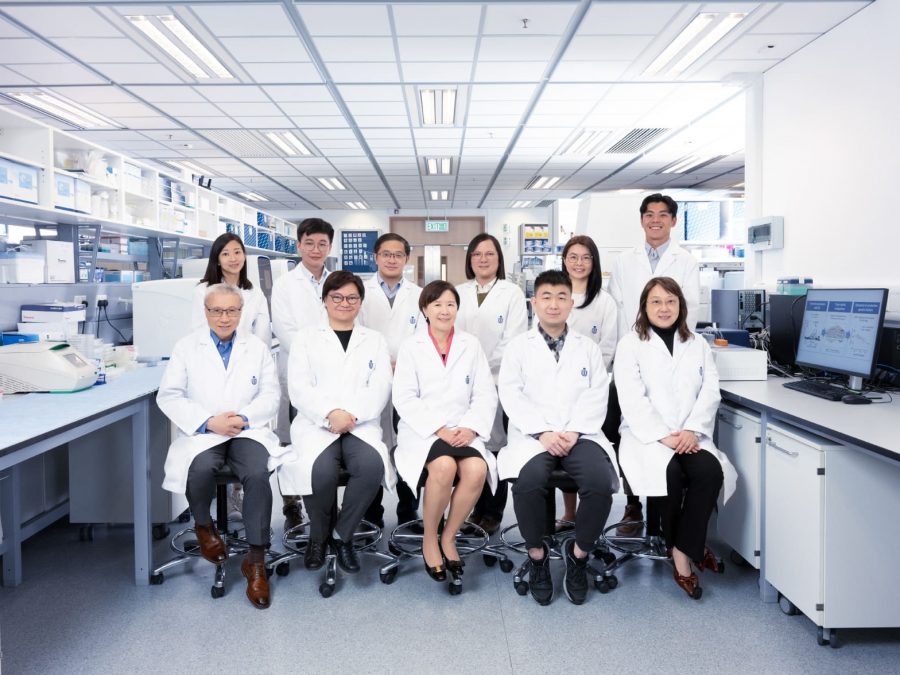
An international research team led by the Hong Kong University of Science and Technology (HKUST) has identified key genetic factors that confer protective effects against Alzheimer’s disease (AD) through a comprehensive genetic analysis of East Asian populations, including Chinese and Japanese, as well as European populations. This groundbreaking discovery sheds light on how these genetic factors can exert protective effects, unveiling the biological mechanisms underlying AD pathogenesis.
At a glance:
In the past decade, research into theSORL1gene (Sortilin-Related Receptor 1) has gained attention in the field of AD, as the protein it encodes, SORL1, plays a crucial role in regulating the production and clearance of amyloid-beta, a toxic protein that contributes to the pathology of AD. Studies conducted in individuals of European descent have suggested that certainSORL1genetic variants exert protective effects against AD, making it a potential target for disease intervention. However, most genetic studies have mainly focused on the European population, leaving gaps in understanding howSORL1variants affect other ethnic groups. Therefore, investigatingSORL1genetic variants in the East Asian population will provide new insights into how these variants may exert protection against AD. This highlights the importance of comprehensive research that includes diverse ethnic groups to enhance our understanding of how ancestral backgrounds influence the genetic mechanisms underlying the disease.
To investigate howSORL1genetic variants protect against AD in diverse populations, a multidisciplinary team led by Prof. Nancy IP, President and the Morningside Professor of Life Science at HKUST and Director of the Hong Kong Center for Neurodegenerative Diseases (HKCeND), performed a comprehensive genetic association analysis across East Asian populations, including individuals from mainland China, Hong Kong, and Japan, as well as European populations. This research was conducted in collaboration with Prof. John Hardy from University College London, Prof. Akinori Miyashita from Niigata University, and Prof. Yu Chen from the Shenzhen Institutes of Advanced Technology, Chinese Academy of Sciences, while also integrating data from international databases, including the Alzheimer’s Disease Neuroimaging Initiative.
The team identified keySORL1genetic variants in both East Asian and European populations. In particular, the Hap_A variant showed a strong protective effect against AD in the East Asian population, while it is relatively rare in the European population. The prevalence of Hap_A in East Asians is 168 times that of Europeans. Their analysis revealed that individuals carrying the Hap_A variant had better cognitive function, decreased neurodegeneration, and less severe AD pathology when compared with those not carrying the variant. Their findings demonstrated that different ethnic groups exhibit distinct sets of variants that exert AD-protective roles.
To further understand the biological mechanisms of these AD-protectiveSORL1genetic variants, the team comprehensively examined the functional roles of the variants. Their results showed that the AD-protective genetic variants are associated with increased SORL1 protein expression and may modulate biological pathways related to both immune and neuronal functions. Notably, the team identified a specific coding variant that regulates the expression and function of a SORL1 protein isoform, which had not been comprehensively studied previously. This finding provides new insights into the molecular mechanism underlying how SORL1 protein modulates AD risk.
“This study enhances our understanding of the role of SORL1 in AD and has uncovered its potential for therapeutic development,” said Prof. Ip. “Our research, built on international collaboration, contributes to one of the most comprehensive East Asian human databases for AD, serving as a valuable resource for studies of AD genetic factors in diverse ethnic populations.”
The research was supported by the National Natural Science Foundation of China (NSFC) and the Research Grants Council (RGC) of Hong Kong Joint Research Scheme and the InnoHK scheme of the HKSAR government. It was conducted in collaboration with researchers from University College London and Niigata University, as well as clinicians from the Prince of Wales Hospital and Queen Elizabeth Hospital. The findings have been recently published inAlzheimer’s & Dementia: The Journal of the Alzheimer’s Association, and featured onAlzforum, a scholarly exchange platform focused on AD research.
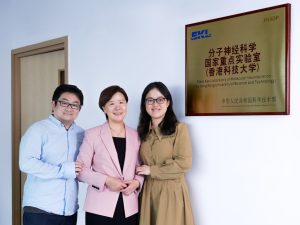
HKUST President Prof. Nancy IP (center) is joined by co-first author of this research paper and former Research Assistant Professor at HKUST Division of Life Science, Prof. ZHOU Xiaopu (left), and former Research Associate at HKCeND, ZHONG Huan (right).
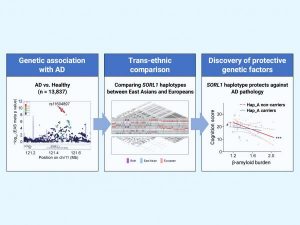
The team has identified numerous SORL1 genetic variants that protect against the risk of Alzheimer’s disease (AD) in the East Asian and European populations. By comparing the genetic structure across different populations, the team has further dissected the most critical AD-protective SORL1 variants in both groups. The specific genetic variant Hap_A of SORL1 is associated with an alleviated cognitive decline in patients with AD, indicating its important protective mechanism.
Reposted from https://hkust.edu.hk/news.
Read More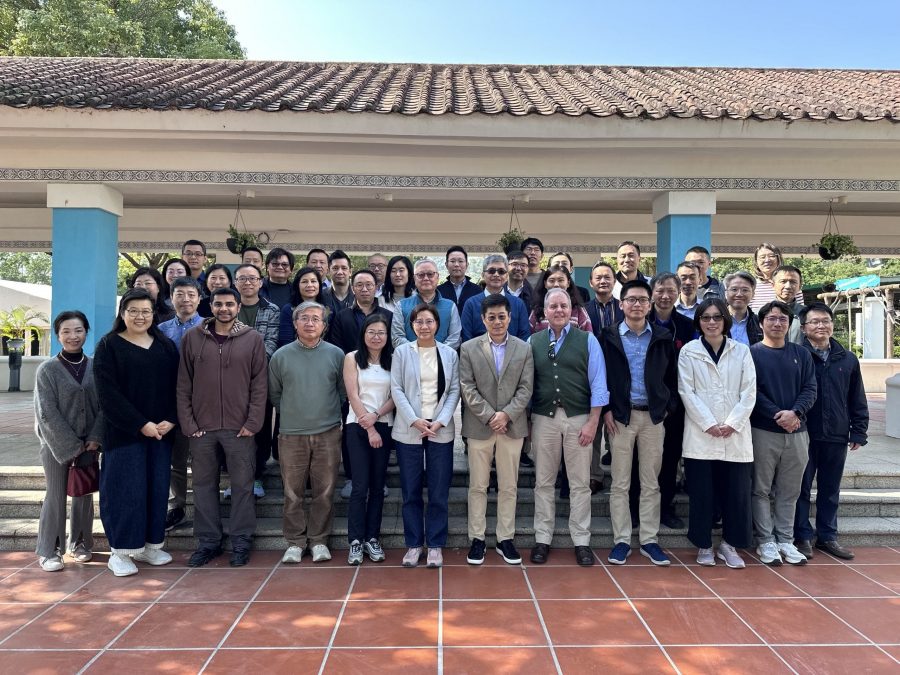
The Division of Life Science (LIFS) Retreat took place on January 9-10, 2025, at the Grand Coloane Resort in Macau, SAR, China. This engaging event brought together over 40 faculty members, including regular and teaching staff, as well as four newly recruited faculty.
The primary objectives of the Retreat were to create a productive environment for collaboration and connection, allowing participants to share insights about their research, strategically plan for the Division’s development, and discuss the undergraduate curricula.
Overall, the Retreat was both productive and enjoyable, offering faculty members valuable insights and perspectives on the Division’s vision and mission and facilitating the exchange of views relevant to the Division.
We sincerely thank all faculty members for their commitment and contributions to making this Retreat a success.
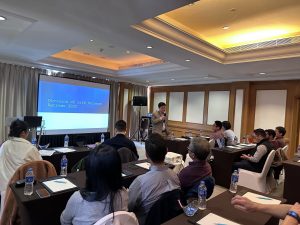
Prof. Guojun BU, Head of Division of Life Science making the opening remarks.
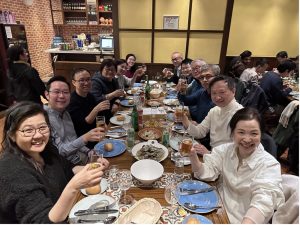
A great dinner after a whole day of fruitful discussions.
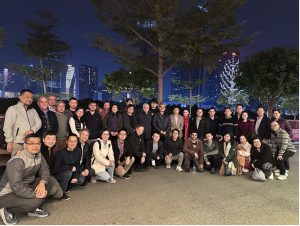
A fun evening to celebrate the end of a day filled with insightful talks.
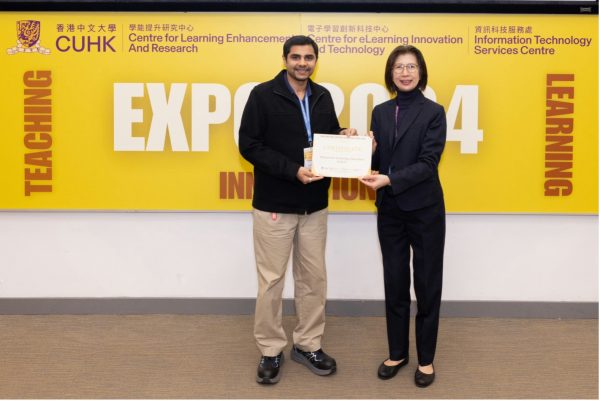
Dr. Aftab AMIN (left) being presented with the Educational Teaching Innovation GOLD poster award by Ms. Carol CHIU, Director of Information Technology Services at Chinese University of Hong Kong (CUHK) at the Teaching and Learning Innovation Expo 2024, held at CUHK on 11-12 December 2024.
Many congratulations to Dr. Aftab AMIN (teaching faculty from the Division of Life Science) for being awarded the Educational Teaching Innovation GOLD poster award at the Teaching and Learning Innovation Expo 2024, held at the Chinese University of Hong Kong (CUHK) on 11-12 December, 2024.
The Teaching and Learning Innovation Expo is one of the major annual events at CUHK since 2007. Dr. AMIN’s work, titled “Advancing Virtual Reality and Gamification Pedagogy for Anatomy, Physiology and Animal Dissection Education” was nominated for this award by the Center for Education Innovation (CEI, HKUST). The project was selected from 114 submissions from various Hong Kong universities.
The Poster Awards Judging Panel included the following members: Dr. Paul CHIN, Head (Learning and Teaching), Centre for Learning and Teaching, University of Bath, UK; Dr. Simon PRATT-ADAMS, Director, Centre of Innovation in Higher Education, Anglia Ruskin University, UK; and Professor Gary K. W. WONG Director, Centre for Information Technology in Education, The University of Hong Kong.
Dr. AMIN was also recently awarded his second Teaching Learning and Innovation Projects (TLIP) grant for a project titled, “Gamification, Virtual Reality Pedagogy for the Provision of Active-Learning in Genetics, Forensics, & Biochemistry Laboratories”, and looks forward to continuing and expanding his collaborations with the faculty and students of HKUST, and the academic community of Hong Kong.
Read More
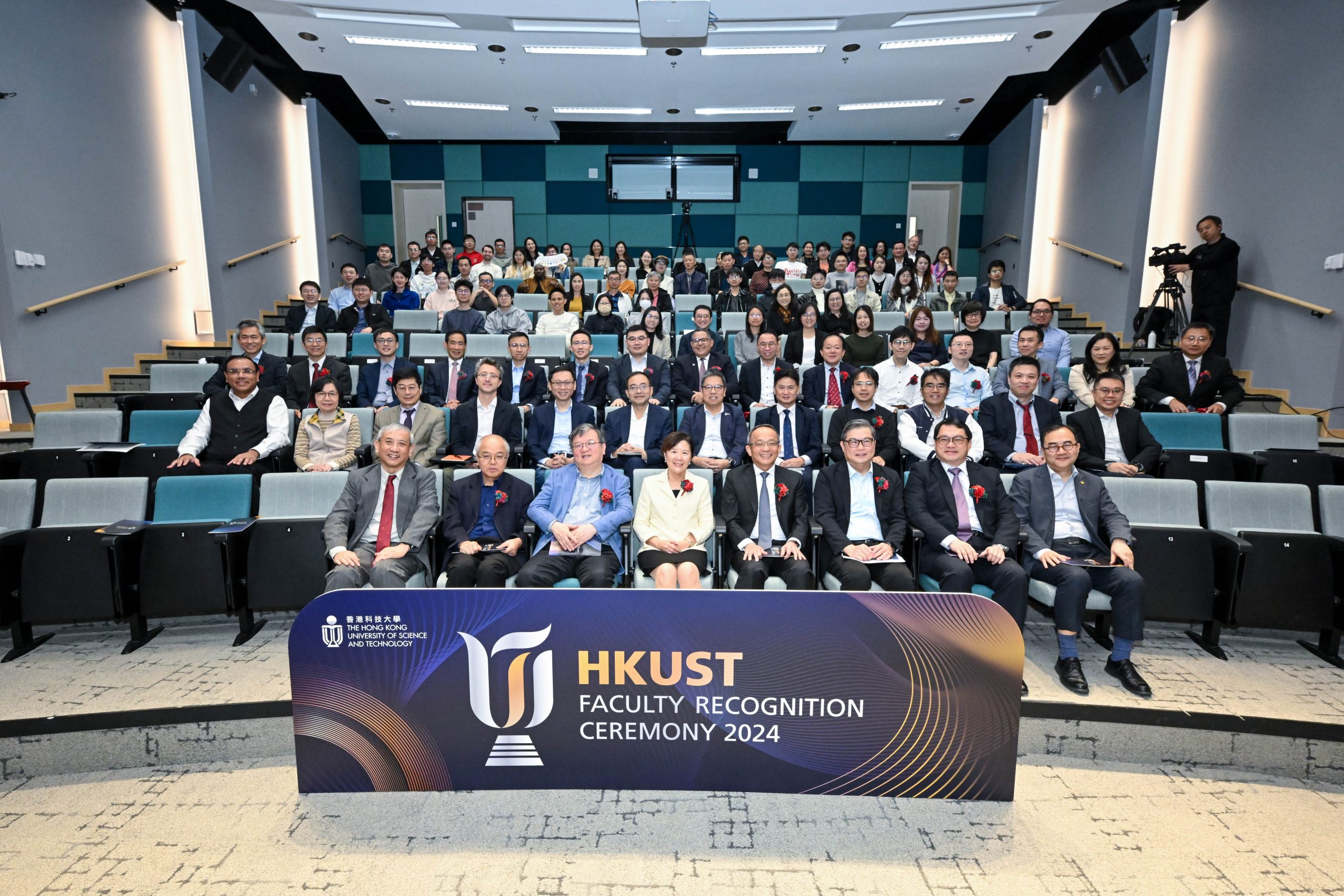
The HKUST Faculty Recognition Ceremony 2024 took place on December 4 to honor and celebrate the outstanding achievements of the University’s faculty during the 2023-24 academic year. Among the 22 honorees, Division of Life Science faculty members Prof. Tom CHEUNG and Prof. Kai LIU were recognized for being named as RGC Research Fellows for 2024/25.
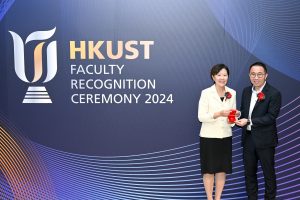
Prof. Tom CHEUNG
Associate Head (Research and Development)
S H Ho Professor of Life Science
Named RGC Research Fellow 2024/25
Received the Healthy Longevity Catalyst Award (Hong Kong) 2023 presented by the RGC in collaboration with the US National Academy of Medicine
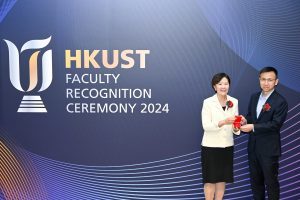
Prof. Kai LIU
Professor in the Division of Life Science and the Department of Chemical and Biological Engineering
Cheng Professor of Science
Named RGC Research Fellow 2024/25
HKUST scholars are acknowledged by internationally accredited institutions for their significant contributions in research discoveries and knowledge transfer activities. Since 2017, HKUST has held an annual Faculty Recognition Ceremony to honor and celebrate the accomplishments of our faculty from the previous academic year.
Read More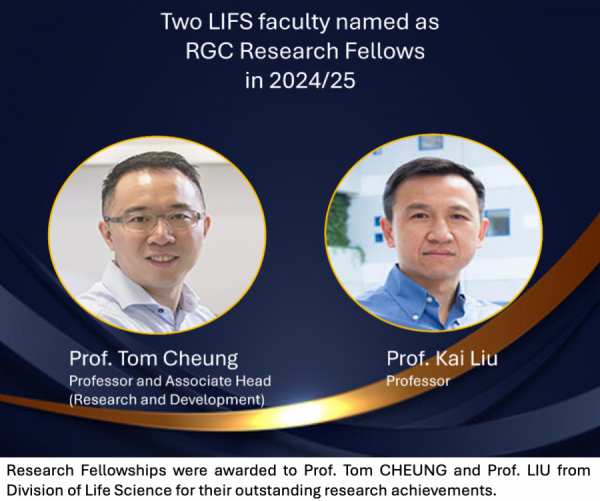
Prof. Tom CHEUNG, Associate Head (Research and Development), Division of Life Science
Project title: Post-transcriptional regulation of muscle stem cell quiescence during physiological conditions and aging
Amount of Fellowship Grant: ~HKD 5.3 million
Abstract
With better healthcare and living conditions, humans are living longer, but aging is accompanied by poorer health span partly due to the aging-related deterioration in tissue functions. Muscle stem cells (MuSCs) are the adult stem cells of skeletal muscle, playing critical roles in maintaining tissue homeostasis and repair. MuSCs remain in a dormant state until they receive signals from external stimuli (e.g. muscle injury) to rapidly activate, proliferate, and differentiate to regenerate the injured muscle. However, this regenerative capacity is lost during aging, leading to loss of muscle mass, function, and capacity for repair. MuSC functions are under tight regulatory control through numerous pathways, which become dysregulated during aging. The Cheung laboratory is dedicated to understanding why MuSC functions are lost and developing interventions to restore their stem cell functions. This project will investigate how these mechanisms regulate MuSC functions and how aging may impact these pathways.
Prof. LIU Kai, Professor, Division of Life Science
Project title: Enhance locomotor recovery by transforming a complete spinal cord injury into an incomplete injury
Amount of Fellowship Grant: ~HKD 5.3 million
Abstract
Severe and long-lasting neurological deficits result from neurological injuries such as brain or spinal cord injury. Successful regeneration and reconnection of nerves has the potential to restore lost function. The team’s previous work on optic nerve injury and regeneration has led to a new approach to promote axonal regeneration and neurological recovery. They will apply this knowledge and methods to spinal cord injury. Recent research on spinal cord injury has shown that multiple descending tracts can regenerate across the lesion site, offering exciting opportunities to study the function of axonal pathways in the regeneration and repair of damaged neural circuits. The team aims to enhance functional recovery by combining various strategies and gain a deeper understanding of the cellular and molecular mechanisms involved in nerve fiber regeneration and functional connectivity. Successful completion of this project will improve our understanding of the fundamental processes that promote functional connectivity after central nervous system injury.
HKUST President Prof. Nancy IP said, “This marks another significant accomplishment of the University, shortly after we yielded impressive results in RGC’s Areas of Excellence and Theme-based Research Schemes. At HKUST, we are committed to attracting and nurturing top-tier research talents who are dedicated to making a pivotal impact on addressing global challenges.
HKUST Vice-President for Research and Development Prof. Tim CHENG also expressed delight at the faculty’s achievements. He said, “Thanks to these additional research funding and support from RGC, our faculty members can dedicate more time to their foundational research and nurturing the next generation of research talent. This is essential for the University to further our goal of making HKUST a powerhouse of innovation and achievement.”
The annual RFS and SRFS aim to provide continuous research support integrated with relief from teaching and administrative duties for a 5-year period to 10 outstanding mid-career researchers at the Associate Professor rank and 10 senior researchers at the full Professor rank at UGC-funded universities in Hong Kong. This initiative is designed to enable academics to focus on research and development, as well as the time and resources necessary to nurture the next generation of local research talents for Hong Kong.
For more information please see:
Read More